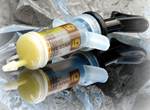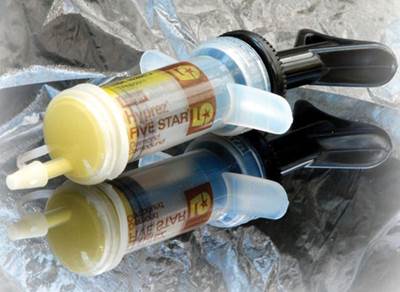Teach Yourself Polishing
Schools for mold polishing do not exist and most veteran polishers don't want to teach the subject, so here are a few simple polishing guidelines.
There are no schools for mold polishing and most veteran polishers don't want to teach the subject. Some may give a few pointers here and there, but for the most part there is no real educational institute for polishing. So, if you're a shop owner who is breaking in a new polisher, practice these simple guidelines.
Use a piece of scrap steel 3"x 3", a cup of mineral spirits, 220-grit YLS aluminum oxide and 320- and 600-grit soft bond silicon carbide stones as you proceed with the following instructions.
Begin by taking a 220-grit stone and estimate how much downward pressure it will take to cut out 75 to 80 percent of the existing tool marks. Then start stoning by hand with this amount of pressure. As you are stoning, pay attention to the individual scratches that are already existing in the steel and the scratches that you are making by hand. The concept behind rough stoning is to remove the rough tool marks, but not to create more work than already exists.
It's an unfortunate reality that far too many polishers destroy the dimensions of the part all because of ignoring the following rule, "You can't use as much steel as you wish to put on a polish. You only have the depth of the tool mark." That simple rule is from where 99 percent of all ruined dimensions come. The polisher has no understanding of where a dimension is; the dimension that the moldmaker intended is exactly at the bottom of the tool mark and not .0001 further.
After you have pressed down hard enough to take out 80 percent of the tool marks, reduce the downward pressure to a degree that will remove 80 percent of the remaining tool marks. Like an airplane coming in for a landing, you too are flaring out at the end to lightly touch down on the dimension. Make sure that you are criss-crossing with your stone the entire time. Criss-crossing entails making "X" patterns in the steel and is easily accomplished by swinging your elbow in and out 15 degrees as you polish. It should always be done when you begin to stone to avoid deep scratches from forming in the steel. These deep scratches form because pores in the stone become clogged with metal powder and stone grit, which causes metal-on-metal scouring. Criss-crossing helps prevent this scouring, but most importantly it allows the polisher to "read" the depth of all existing scratches.
A professional polisher creates a controlled scratch - a scratch with the exact depth and consistency they desire; not a depth and consistency the stone gives them. Now that 99 percent of the tool marks are out, go over the block with as light a pressure as you can to "soften up" the 220 scratches. A short stroke by hand - of about one to two inches - will produce fewer "tear marks" and finer scratches than a stroke longer than two inches. So, keep your strokes to less than two inches in length whenever stoning by hand.
Now that the 220-grit stoning is as fine as you can get it, rotate the practice block 45 degrees and begin using the soft bond 320 stone. Try to determine how deep the 220 scratch marks are and use just enough pres-sure to take out 80 percent of those scratches. Since the block orientation is now lined up in a different direction, all of the older, deeper scratches become readily visible. This allows the polisher to easily "read" exactly where the scratches are and exactly when they will be done. Here, the polisher is working with the steel. The two are communicating easily to each other as the work progresses and control has taken over chaos.
While taking out the 220 marks you will inevitably come across a few deep scratches - possibly one deep scratch in a sea of finer scratches which is when the real training begins - which you must criss-cross and press gradually harder until they begin to fade away. As they fade, reduce your downward pressure until everything disappears. Find another deep scratch and perform the those same steps until you can really understand the relationship between scratch depth, pressure applied and lightening up as the scratch disappears.
This exact same procedure - with even finer scratches - is applied across all levels of the polishing process, regardless if it's 220, 320, 400, 500, 600 or 900 stoning, brushing with diamond, buffing with felt or buffing by hand with facial tissue. The process explained here - pressing a little harder when needed and then lightening up as the scratch goes out - will never change. All polishers claim to do it, but few actually do in reality.
After you finish and the 320-grit is as fine as it will go, don't wipe off and throw away the honing fluid that's left over from the 320 stoning. This fluid is actually the best and most expensive polish you'll ever have. It's a micro-fine consistency polish that, when massaged in between the stone and the steel, will cut all polishing times by 30 percent or more. Honing fluid, when properly used, is liquid speed because your next finer grit stone will have no work left to do - that's where professionalism and speed come from as well as the reward of higher pay. Do this with every grit stone.
Next, rotate the block another 30 degrees and visualize the depth of the scratch. Try to stone with only enough pressure to take out 80 percent of those marks. If you have done everything properly, you should start to notice that the job is picking up speed; that stages are getting faster and faster. This is not automatically the case whenever anybody polishes. It's only the case when you are doing these steps properly.
Many polishers in the business for 30 years take just as long with their final step as with their first step. This is because they never learned to stop grinding their stones into the steel and they treat each step as if it were rough stoning. You only rough stone during the first step when you're dealing with the original tool marks. From then on you're polishing - even with a stone.
Learn to use your stone to rough when you need it, how to create softer scratches and how to use the honing fluid as a last "polishing" step. If you want to become a professional polisher, test every stone on a scrap piece of steel, press down as hard as you can and gradually work your way up to the finest polish you can get out of that stone. Teach yourself to know exactly what the total range is of each stone. Experiment to find the fastest way of climbing up the ladder of finer scratches by mixing and matching every type of stone. Then prove your results by testing how easily a brush with diamond takes out your final scratches. That is the real test and the only one that counts. By paying attention to the existing scratch depth and the depth of those you're now making - by criss-crossing and polishing with the honing fluid - you will never be bored with your work and will only get faster and more professional with each job.
Related Content
What Is Scientific Maintenance? Part 1
Part one of this three-part series explains how to create a scientific maintenance plan based on a toolroom’s current data collection and usage.
Read MoreWhat is Scientific Maintenance? Part 2
Part two of this three-part series explains specific data that toolrooms must collect, analyze and use to truly advance to a scientific maintenance culture where you can measure real data and drive decisions.
Read MoreFour Micro Tooling Considerations
Issues involving gating, ejection, mold splits and direction of pull are of special concern when it comes to micro tooling.
Read MoreLine Width vs. Depth Ratio in Laser Engraving
A laser does not produce 90-degree sidewalls. It requires a certain amount of draft in order to produce the required pattern.
Read MoreRead Next
Mold Polishing Compound Improves Cutting Speeds
Engis says its Hyprez Five Star/US diamond compound is suitable for use in virtually all polishing applications. In particular, it is designed to produce high-luster finishes on molds. The compound combines the cutting characteristics of natural diamond with the durability of manufactured diamond to create an all-purpose, precision blend that is said to increase cutting speeds and lengthen service life.
Read MoreHow to Use Continuing Education to Remain Competitive in Moldmaking
Continued training helps moldmakers make tooling decisions and properly use the latest cutting tool to efficiently machine high-quality molds.
Read MoreReasons to Use Fiber Lasers for Mold Cleaning
Fiber lasers offer a simplicity, speed, control and portability, minimizing mold cleaning risks.
Read More




















